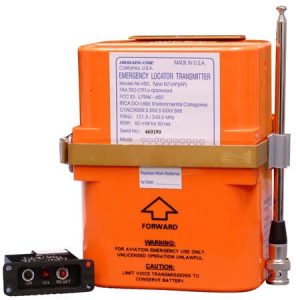The ELT Conundrum
I was recently approached with a concern by an Examiner, as in Designated Pilot Examiner (DPE), a
designee of the Federal Aviation Administration who is tasked with the testing of applicants for pilot
certificates and ratings. He wanted to address an issue that so many of the applicants he was testing
did not seem to understand. That issue being the typical questions concerning the Emergency
Locator Transmitter (ELT) and its battery.
An ELT is a radio that is designed to assist in locating a distressed aircraft.
To properly answer the typical line of questioning regarding ELTs one must first understand whether
the question being posed is in reference to the ELT itself or the battery that powers the ELT.
WHAT YOU SHOULD KNOW ABOUT THE ELT ITSELF:
The most common question that will be asked pertaining to the ELT itself has to do with the
functionality test of the radio. Federal Aviation Regulation (FAR) 91.207(d) requires that each ELT
radio be inspected within 12 calendar months. It must be inspected for the following:
‐ Proper installation
‐ Battery corrosion
‐ Operation of the controls (switches)
‐ The presence of sufficient signal radiated from its antenna
It strikes me that perhaps many experienced pilots, as well as student pilots, struggle to remember
the ELT testing requirement because it is identical to the time requirement for the aircraft to have an
(Annual) Inspection. As a matter of practice, the ELT inspection is typically complied with during the
Annual Inspection of the aircraft. The FAA would give the nation’s student pilot population one less
thing to remember if they would just remove this requirement from FAR 91 and place it in FAR 43,
Appendix D – Scope and Detail of Items to be Included in Annual and 100‐Hour Inspections. Since
that is not the case and not likely to change, Applicants for pilot certificates and ratings will continue
to be tested on this regulation. Just remember that the ELT must be inspected within 12 calendar
months. You will find evidence of such included in the maintenance logbook entry for the most
recent Annual Inspection of your aircraft.
WHAT YOU SHOULD KNOW ABOUT ELT BATTERIES:
Here’s where it gets complicated. Okay, not really. But remember most people who are answering
these questions are facing an oral exam by a Pilot Examiner or a Flight Review by a Flight Instructor.
There is sometimes quite a bit of stress involved! Let me try to help. Just remember there are only
two instances in which you need to be concerned with replacing your ELT batteries. If you really
want to impress the DPE or CFI just flip open your well‐worn (but current) copy of the FARs to
91.207(b).
Here you will see that ELT batteries must be replaced if the ELT transmitter has been in use for
more than one cumulative hour. This means that if the ELT was turned on, accidentally or otherwise,
for 40 minutes last week and again this week for more than 20 minutes you are required to replace
the batteries since the cumulative time the ELT was transmitting exceeds one hour. Many times ELTs
are activated unintentionally and there is no way to determine how long it has been transmitting. If
you want to be sure that the ELT isn’t transmitting before parking and securing your aircraft, take a
minute to dial in 121.5 in a COMM radio and listen for the signal. Who knows, it may save you the
cost of a battery!
The second instance in which the ELT batteries must be replaced is when 50% of their useful
life has expired. Continuing to read in 91.207(b)(2) we see that the expiration date for replacing
the battery must be legibly marked on the outside of the transmitter and entered in the aircraft
maintenance logbook. This expiration date IS the half‐life of the battery, aka when 50% of the
battery’s useful life has expired. Look for the maintenance logbook entry when the ELT battery
was last replaced and you will find an indication of the half‐life of the new batteries.

So let’s review the ELT conundrum…
First, is the question being asked about the ELT Inspection or the ELT battery? If about the Inspection
it is due every 12 calendar months.
If the question is about the ELT battery remember that it needs replaced when: 1.) the transmitter
has been used for one hour TOTAL or, 2.) at the date stamped on the battery which is the battery
half‐life.
As with many questions pertaining to the Federal Aviation Regulations the answers aren’t usually
that difficult if you break it down into manageable pieces. Remember also that you can always look
up the appropriate regulation, using the FAR Index if necessary, to help you answer the question. It
may feel a bit like cheating but nobody can remember every regulation. As pilots it is important not
only that we commit to memory the appropriate material but also that we know how to use the
proper references to find the correct answers to our questions.
